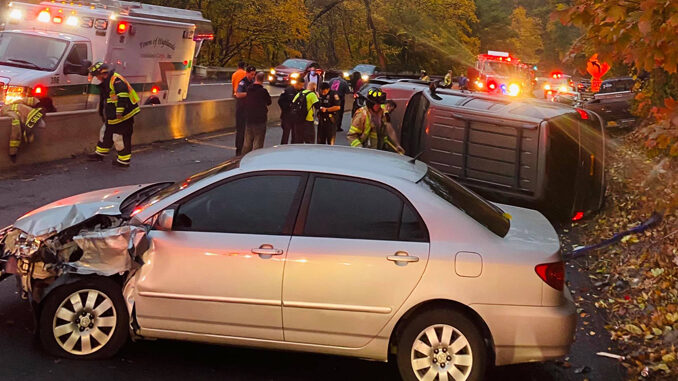
Despite improvements, Rt. 9W over Storm King a challenge
In this eternal struggle of man versus nature, nature usually ends up winning. Man continues to push back, but nature consistently finds a way to come out ahead. In this narrative, the tag-team duo of Storm King Mountain and Mother Nature form the formidable enemy against humanity.
For years motorists have tried to overcome the steep incline and sharp turns of the mountain’s roadways combined with treacherous weather conditions such as snow/ice, rain, and fog.
Despite efforts to mitigate the number of accidents which occur annually, man is usually on the losing end.
The most recent incident took place on March 17 when wet roads and a drop in temperature left an icy patch on the southbound side of the mountain, causing an accident. Route 9W was closed for nearly two hours as the vehicles were cleared and the DOT made its way up with a salt truck to treat the roadway.
Although, in recent years, the DOT has gotten better about making sure salt is applied to Storm King Mountain before the morning commute; many times motorists have been left stranded due to icy conditions.
In 2015, in an effort to improve roadway conditions and responses to emergencies, Kurt Hahn, director of the Cornwall Office of Emergency Management, spearheaded the first Storm King Roundtable. The committee was made up of police and fire chiefs, as well as EMS personnel in both the Highland Falls and Cornwall communities, New York State Police, Orange County Emergency Services, local and regional DOT representatives, local and state officials, and representatives from West Point.
The first roundtable meeting was successful in having mile markers placed on the Jersey barriers between Cornwall and Highland Falls so motorists would be able to provide location information to 9-1-1 operators in the event of an emergency.
“There are no landmarks between Cornwall and West Point,” Hahn said. “Because of the unknown locations it required three different agencies from three different municipalities to be dispatched at the same time to those emergencies. During the winter and given limited access because of the Jersey barriers and traffic we’re going to jam up our own residents by being stuck on the mountain for a wild goose chase.”
The placement of the mile markers greatly reduced the number of unknown location calls so only one jurisdiction was being dispatched.
After that meeting, additional attention was given to roadway maintenance.
“We realized there was a breakdown as far as communication goes between DOT and first responders,” Hahn said. “That was how to get sanders and salt in a timely manner. We found that the DOT was required to only fill salt trucks in Newburgh and not at the West Point substation at 218 and 9W which we thought was absurd.”
Salt trucks would make their way up the mountain and have to turn around and head back to Newburgh to fill up with salt before being able to complete treatment of the roadways.
“We were able to chip through that bureaucracy and get everyone to work together to make sure we’re doing the right thing as far as salt and sand goes which definitely improved the safety of the roadway for motorists,” Hahn said. “We had a reduction in accidents.”
“We realized there was a breakdown as far as communication goes between DOT and first responders.”
Kurt Hahn, director, Cornwall Office of Emergency Management
In 2018, the 5.4 mile stretch of Rt. 9W from Angola Road to the Rt. 218/293 Interchange in the Town of Highlands was repaved. When the project was completed motorists began submitting complaints to the DOT reporting seemingly worsening flooding conditions. Through the grassroots effort by several members of the Facebook group, “Status of Storm King,” the DOT implemented a plan to improve drainage issues. The asphalt gutters were upgraded in 2019 to improve the flow of water from the mountain.To date, some of those issues still exist despite efforts to correct the situation.
“When you have intense duration rainfall events, flooding in neighborhoods occurs,” Hahn said. “But on a mountain, the way the geography is, there are not many places for it to go. Water is going to find the path of least resistance. If that happens to be across four lanes of traffic, that’s where it goes. No matter what improvement they [the DOT] do, it would take significant capital investment such as cutting more rock back to create a greater shoulder to absorb that rainfall capacity. It’s very challenging.”
Hahn said he’d like to schedule another roundtable meeting in the future to discuss the feasibility of using more technology to alert motorists and the DOT if there are any issues. In 2015, temporary electronic signs were placed on either side of the mountain to inform motorists of conditions on Storm King. A year earlier, the Facebook group “Status of Storm King” was created to provide up to the minute updates on road conditions. Today, over 7,000 individuals rely on reports from other motorists before challenging the mountain.
Hahn said he’d like to see the use of roadway sensors and cameras to provide real-time road conditions. He also suggested the DOT send HELP trucks to patrol the area frequently. The Highway Emergency Local Patrol program provides free roadside emergency services on many major roads throughout the state during peak travel times.
According to a spokesperson from the DOT, the safety of the traveling public is always a top priority. Roadways conditions on Route 9W are monitored and maintenance work and enhanced snow and ice removal is performed as necessary. The DOT is studying further safety enhancements on Storm King Mountain, but in the meantime motorists are urged to drive with caution, especially during inclement weather, and obey posted speed limits.
Storm King Mountain motor vehicle accidents
Town of Cornwall
2015 – 51 crashes; 10 with injury*
2016 – 23 crashes; 7 with injury
2017 – 23 crashes; 6 with injury
2018 – 23 crashes; 4 with injury
2019 – 20 crashes; 3 with injury
2020 – 29 crashes; 5 with injury
*A crash with an injury has one or more people injured or reporting injuries. These numbers do not include any car/deer or car/ bear crashes



